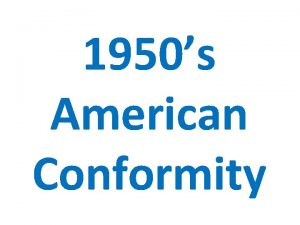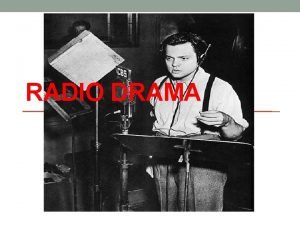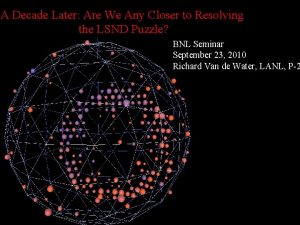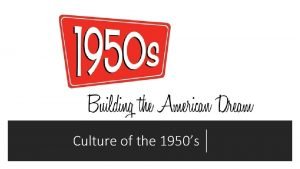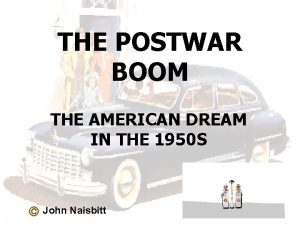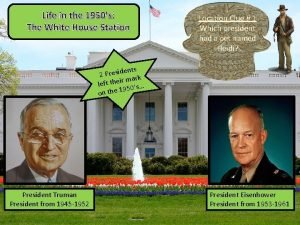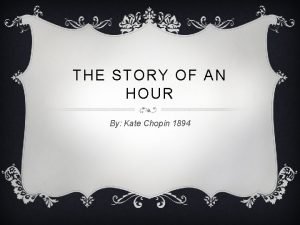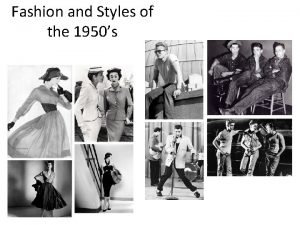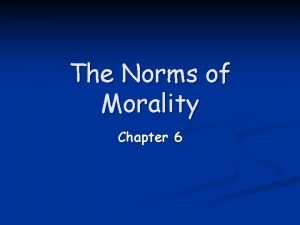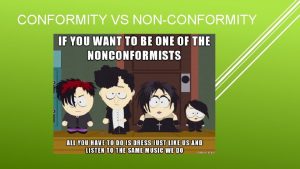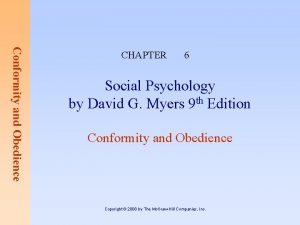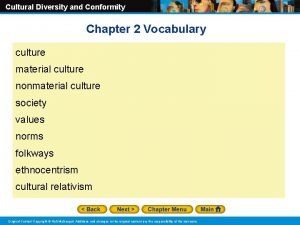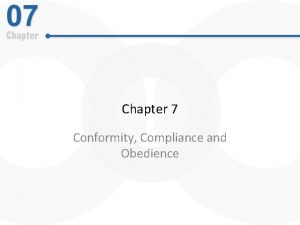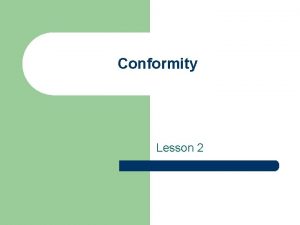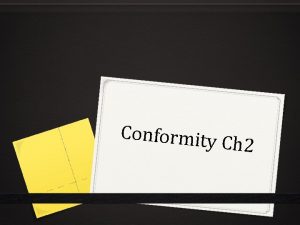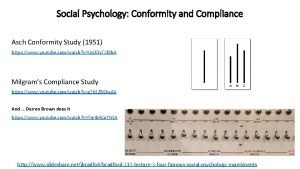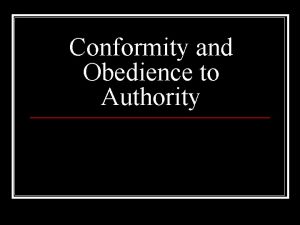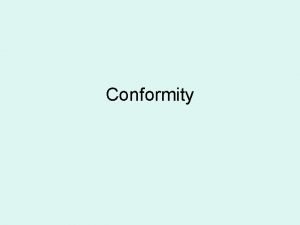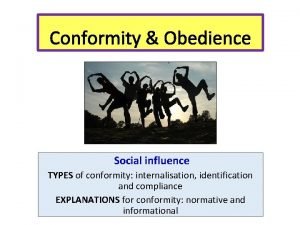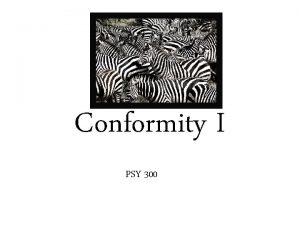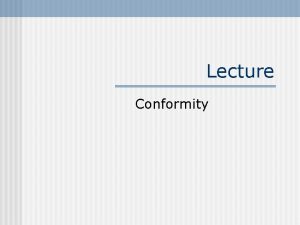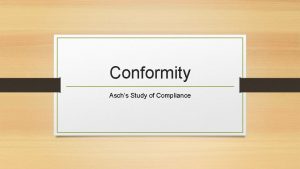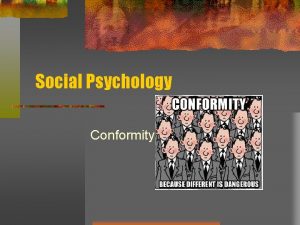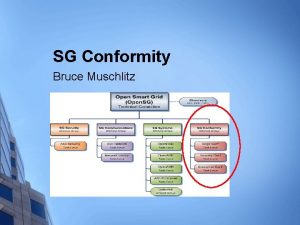1950s American Conformity Throughout the decade of the














































- Slides: 46

1950’s American Conformity

Throughout the decade of the 1950’s “Middle Class” Americans thought, acted, looked, and lived the same. Given this time of mass conformity, there are three things we need to examine: 1. Evidence of conformity 2. Why people desired conformity 3. Challenges against that conformity

Examples of 1950’s Conformity

1. The Baby Boom

During the 1930’s many couples thought twice about having children. Why?

During the 1940’s many couples thought twice about having children, or were otherwise prevented from having them. Why?

By 1950, those problems were mostly gone.

America’s soldiers came home and readjusted to civilian life. The G. I. Bill enabled record numbers those soldiers to attend college and trade schools and qualify for a low interest home loan.

Consumer spending, and government investment in cold war military production allowed the US economy to grow by leaps and bounds.

These factors provided the perfect conditions for couples to have children.

1957 1 baby born every 7 seconds

2. The Growth of Suburbs

With the growth of families, new housing needs arose. Increasingly, families found that housing in the suburbs.

Middle class families were increasingly able to move from downtown areas of cities, to the outskirts of those cities. Two things really made this possible: - Government home loans - The new interstate highway system

Why would a family choose to live in the suburbs instead of downtown?

Levittown, NY “The American Dream” 1949 William Levitt produced 150 houses per week. $7, 990 or $60/month with no down payment. (About $100, 000 today)

1 story high 12’x 19’ living room 2 bedrooms 1 bathroom garage small backyard front lawn By 1960 1/3 of the U. S. population in the suburbs.

This move to the suburbs had important consequences: White, middle class families increasingly left the cities. Who remained behind?

3. Gender Roles

Middle class society had very clear expectations for men, women and teenagers.

Men: - Breadwinner: Go to work, earn a paycheck, support the family - Boss of the house, king of the castle: Wife and kids do what he says

Women: - Left the wartime workforce and went home to raise children - Homemaker: Take care of the family, take care of the house - Cook, clean, and look good doing so! (Dress, heels, makeup, hair done)

Women: - Some middle class women continued to work. - Those that did were usually single and often quite those jobs when they got married. - Did stereotypical women’s job: teacher, librarian, nurse, secretary

Single middle class men and women were expected to get married and to stay that way. Divorce wasn’t really an option.

Teenagers: - Obey authority (parents, teachers, cops, anyone older and therefore wiser than you) - Don’t make waves, fit in with the group - Control your emotions - Don’t even think about S. E. X. !!!

4. Television

1946 7, 000 TV sets in the U. S. 1950 50, 000 TV sets in the U. S.

Many popular shows celebrated traditional American values. (Truth, Justice, and the American way!) Why?

Many of the most popular shows reflected society’s gender expectations. I Love Lucy 1951 -1957

Leave It to Beaver 1957 -1963 Father Knows Best 1954 -1958

5. Consumer Culture

With a booming economy, people had money to spend. As such, they bought the latest and greatest stuff, stuff they had seen advertised on television.

Some Americans couldn’t afford to buy what their neighbors were buying. How could they get in on the action?

6. Church

More and more American families went to church. Church membership: 1940 64, 000 1960 114, 000 Today in the U. S. , the Christian faith is back in the center of things. -- Time magazine, 1954 Why?

Why did middle class Americans desire conformity?

- Watch out for those who don’t conform, for those who stick out! Why?

The early Cold War was full of constant tension and anxiety Conformity was comfortable. People knew what to expect from their daily routine.

Although the vast majority of middle class Americans embraced this culture of conformity, there were those who rejected it and denounced a society full of short comings.

Challenges to Conformity

Rock n’ Roll How did music represent a challenge to the conformity of the 1950’s?

Sexual Practices Sociologist Alfred Kinsey began to study what Americans were up to behind closed doors. 1948 Sexual Behavior in the Human Male 1953 Sexual Behavior in the Human Female Kinsey reached two conclusions about Americans: 1. Premarital sex was common. 2. Extramarital affairs were frequent among married couples.

Sexual Practices Hugh Hefner launched Playboy magazine in 1953. “The Girl Next Door” Sex is okay!

Civil Rights Movement

Feminist Movement

Fin.
 1950s conformity examples
1950s conformity examples 1950s conformity and counterculture
1950s conformity and counterculture Roaring 20s fashion
Roaring 20s fashion The sixties a decade of protest and change
The sixties a decade of protest and change 4017 decade counter
4017 decade counter Record peach harvest—price lowest in a decade
Record peach harvest—price lowest in a decade What decade did radio drama achieve widespread popularity?
What decade did radio drama achieve widespread popularity? Safe system engineering workshop
Safe system engineering workshop Different types of serial killers
Different types of serial killers Chapter 14 the sixties a decade of protest and change
Chapter 14 the sixties a decade of protest and change Who cared for lennie before george
Who cared for lennie before george 1 decade later
1 decade later Biotics research uk
Biotics research uk Computers in the 1950
Computers in the 1950 1950s beatnik fashion
1950s beatnik fashion Suburban life 1950s
Suburban life 1950s Trends of 1950s
Trends of 1950s Mass media in the 1950s
Mass media in the 1950s 1950s concept cars
1950s concept cars Trends of 1950s
Trends of 1950s 1950 school punishments
1950 school punishments Ron offutt house
Ron offutt house Red scare 1950s
Red scare 1950s White house 1950s
White house 1950s The affluent society 1950s
The affluent society 1950s Wwii show
Wwii show Trends of 1950s
Trends of 1950s Catcher in the rye 1950s culture
Catcher in the rye 1950s culture 1950s home economics textbook
1950s home economics textbook Beat writers 1950s
Beat writers 1950s 50s music trivia questions and answers
50s music trivia questions and answers Trends of 1950s
Trends of 1950s Trends of 1950s
Trends of 1950s Pop culture of the 1950s
Pop culture of the 1950s Trends of 1950s
Trends of 1950s It is the remote norm of morality.
It is the remote norm of morality. Conformity orientation
Conformity orientation Unconformity
Unconformity Conformity vs nonconformity
Conformity vs nonconformity What is conformity
What is conformity Obedience and conformity
Obedience and conformity Cultural diversity vocabulary
Cultural diversity vocabulary Obedience psychology
Obedience psychology In asch's study which of these lowered conformity rates
In asch's study which of these lowered conformity rates Cultural diversity and conformity section 2
Cultural diversity and conformity section 2 Tendency to conform
Tendency to conform Asch conformity experiment
Asch conformity experiment
